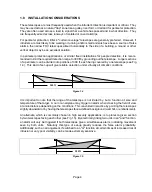
SECTION 1 - - INTRODUCTION
1.1
RANGE AND PERFORMANCE
The range of these telescopes is nominally 500 feet (with appropriate customer supplied electronics)
for personnel and farther for vehicles. HOWEVER, range is dependent on the thermal contrast
between the target and the background. You will find that this varies throughout the day, with weather
conditions, and even with the clothing of the target. If your application involves detecting someone
crossing through a field of grass, you will find that the undulation of the grass on a windy day will
appear on the analog output signals. Thus the system is limited by the thermal contrast of the target
against the background as well as thermal background noise.
For shorter range (~200 ft) or more covert applications, Eltec suggests the Model 8502M3 or 8502M7.
The Model 8502M3 is a short range version of the Model 860M5 and the Model 8502M7 is a short
range version of the Model 860M6. The short range and long range versions are pin for pin compatible
and use the same connector. The short and long range versions differ with regard to directionality
(refer to the Directionality Considerations section for the appropriate Model).
Performance will greatly depend on the amplification you use with the telescope’s analog output
including your bandpass filtering. Many feel that human motion is sufficiently detected through the
frequency range of 0.3 to 3 Hz. Yet, the conditions of your application may require a broadening of
that range - - with a consequent increase in noise. Eltec recommends that you AC-couple the
telescope’s analog output. The current draw per channel should be typically 8 microamps.
1.2
BASICS OF PASSIVE INFRARED (PIR) DETECTION
Each person, object or animal emits infrared energy as a function of its surface temperature and size.
For temperatures around ambient the maximum of the radiated energy is in the region of 10 microns
(20 times the wavelength of visible light). Thermal changes, relative to the background, within the
telescope’s field of view as produced by a moving target generate a signal which will trigger an alarm.
PIR detection has become the most widely used approach for indoor intrusion detection and Eltec
provides a proven high reliability sensor for both indoor and outdoor applications.
PIR detection does not require an emitter, but makes use of radiation which is already there - 100%
natural and harmless. The fact that no radiation is emitted also means that:
•
A sensor unit cannot be detected by any technical means. Like the human eye, it is completely
passive in operation.
•
No license is required as for microwaves.
•
No eye protection required as with many active IR devices.
•
Neighboring units will not interfere with each other.
•
Directional information can be obtained utilizing an internal two channel detector and appropriate
external electronic circuit.
1.3
DESCRIPTION
These telescopes are specifically designed for use as a component in a total security system for long
range detection of people and vehicles. Eltec’s passive infrared thermal telescopes have been
Page 1




























